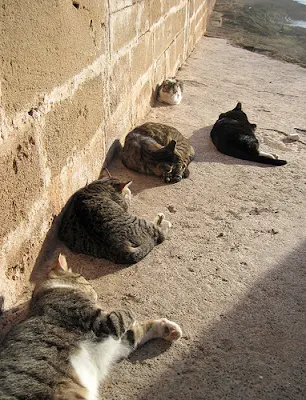VG asks the question as to whether cats in groups are more orderly than previously thought. She noticed how the cats of Morocco were orderly when looking for food from people and when resting. Here is a photo that illustrates that:
 |
| Cat colony - photo copyright valleygirl_tka |
I am going to attempt to answer the question as to why cats form orderly "queues" and rest and sleep in an orderly manner. This comes straight from my head and no reference works have been referred to. Comments therefore would be welcome and I don't mind if they are critical.
Cats are essentially solitary animals. Lions are an exception, living in prides. The domestic cat is a domesticated and evolved African and Eastern European wildcat. These wildcats are solitary animals.
Given a choice, therefore, feral cats will live pretty solitary lives. The choice comes from availability of food and space. If the habitat is right the feral domestic cat will roam widely and be solitary. Some feral cats in Australia are like this. The live off native wildlife and the Aussies don't like it. There is sufficient prey to support feral cats.
The cats that VG photographed were urban, domestic, semi-domestic and feral cats. These cats mainly rely on food that originates with people. It might be waste human food or cat food provided by people or raw food such as fish etc.
 |
| Cat Queue - Photo copyright: valleygirl_tka |
A typical scenario would be cats congregating at a fishing port. There is a ready and steady supply of food at one place.
The primary objective of the feral cat is survival and a food source takes precedence over everything including the natural urge to be solitary. Therefore the cat adapts its behavior and forms groups.
Where there are groups a hierarchy is set up, which creates some order. The natural urge for individual space competes with the need to be at the source of food. These competing forces results in a certain distance being maintained. The queues for food are probably based on the hierarchy that has been established. Multicat households are based on the same principles.
Survival beats all preferences, though. When I holidayed in Italy about 25 years ago I remember that the feral cats outside our hotel room stacked up like double decker buses at night when the temperature dropped. One cat would lie on top of another. This kept both warm. There was no space between them, obviously.
The cat will fill space to an area the size of about 9 square kilometres if the food source and circumstances allow. Cats also adapt very well when they have to and can live permanently indoors in an apartment, a fraction of an acre. The expansion and contraction of overall space dictates the amount of space around the individual cat.
My old lady cat likes a bit of space around her. She keeps a decent distance from my three legged boy cat. She keeps a distance from me when resting that is the same as that in VG's photo above. This might be the "minimum default individual space allowance" of the typical domestic cat when living in a group or cat colony. Cats that are a little outside the main group are probably outsiders, at the bottom of the hierarchy, wanting to get in.
A visitor's page: Feral Cat Colony.
From Cat Colony to Home Page



I found your information about feral cats very informative. I have a question that I have not found an answer for on all the different feral cat websites I have visited. We have a small colony of feral cats and about two months ago a domesticated cat showed up she is now bulling the other cats and chasing them off. The cats started arriving about 7 yrs ago, 2 yrs ago and 2 more this year they no longer stay here except to eat because of the bully. What can we do to protect the cats from the bully? She is very affectionate with me but not my husband. I don't want to call animal control because I know they would put her down.
ReplyDeleteHi, thanks for visiting and asking. Some cats are alpha, male or female. She might consider the area as her home range. The feral cats are on her territory but the feral seem to have been there first in which case appears to be creating a home range.
DeleteShe might be intact. That may enhance her alpha tendencies. Do you know if she is spayed or not? If she is not spayed perhaps trapping and spaying her might help. If she is spayed but still dominant/bullying I don't think there is much that can be done because it is natural.
Do you know the owner? Could she be adopted by someone away from the area?
Sorry I can't give a more helpful answer but I don't think there is one.